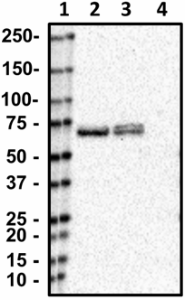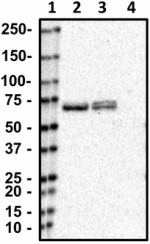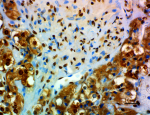- Clone
- Poly28585 (See other available formats)
- Regulatory Status
- RUO
- Other Names
- DBH, Dopamine Beta-Hydroxylase
- Isotype
- Rabbit Polyclonal IgG
- Ave. Rating
- Submit a Review

| Cat # | Size | Price | Quantity Check Availability | Save | ||
|---|---|---|---|---|---|---|
| 858501 | 25 µg | 100€ | ||||
Dopamine beta-hydroxylase (DbH) is a homotetramer enzyme that catalyzes the chemical reaction that converts dopamine to norepinephrine. It is the only known membrane-bound enzyme capable of synthesizing a small-molecule inside synaptic vesicles. DbH is expressed in noradrenergic nerve terminals and in chromaffin cells of the adrenal medulla. Clinically, low levels of DbH expression is identified as DbH deficiency, and has been shown to correlate with conditions associated with addiction, decision making, ADHD and Alzheimer’s Disease.
Product DetailsProduct Details
- Verified Reactivity
- Human
- Antibody Type
- Polyclonal
- Host Species
- Rabbit
- Immunogen
- Recombinant DbH (His335~Val571) expressed in E.coli.
- Formulation
- 0.01 M PBS, pH7.4, containing 0.02% NaN3, 50% glycerol.
- Preparation
- The antibody was purified by affinity chromatography.
- Concentration
- 0.5 mg/ml
- Storage & Handling
- Store at 4°C for up to 3 months. For longer term storage aliquot into small volumes and store at -20°C.
- Application
-
WB - Quality tested
IHC-P - Verified - Recommended Usage
-
Each lot of this antibody is quality control tested by Western blotting. For Western blotting, the suggested use of this reagent is 1.0 - 5.0 µg per ml. For immunohistochemistry on formalin-fixed paraffin-embedded tissue, a concentration range of 0.5 - 2.0 µg/ml is suggested. It is recommended that the reagent be titrated for optimal performance for each application.
- RRID
-
AB_2801220 (BioLegend Cat. No. 858501)
Antigen Details
- Structure
- DbH is a 617 amino acid protein with an apparent molecular mass of ~ 69 kD.
- Distribution
-
Tissue Distribution: Adrenal gland, colon, and brain
Cellular Distribution: Extracellular, cytoskeleton, and endoplasmic reticulum - Function
- DbH is the enzyme that catalyzes the chemical reaction to convert dopamine to norepinephrine.
- Interaction
- Forms homotetramer
- Cell Type
- Neurons
- Biology Area
- Neurodegeneration, Neuroscience, Neuroscience Cell Markers, Synaptic Biology
- Molecular Family
- Enzymes and Regulators, Presynaptic proteins
- Antigen References
-
- Nagatsu T, et al. 2016. J Neural Transm (Vienna). 123(11):1255
- Patriquin MA, et al. 2015. Psychiatr Genet. 25(5):181
- Kopeckova M, et al. 2006. Neuro Endocrinol Lett. 27(6):748
- Gene ID
- 1621 View all products for this Gene ID
- UniProt
- View information about DbH on UniProt.org
Related FAQs
Other Formats
View All DbH Reagents Request Custom Conjugation| Description | Clone | Applications |
|---|---|---|
| Purified anti-DbH | Poly28585 | WB,IHC-P |
Compare Data Across All Formats
This data display is provided for general comparisons between formats.
Your actual data may vary due to variations in samples, target cells, instruments and their settings, staining conditions, and other factors.
If you need assistance with selecting the best format contact our expert technical support team.

 Login / Register
Login / Register 












Follow Us